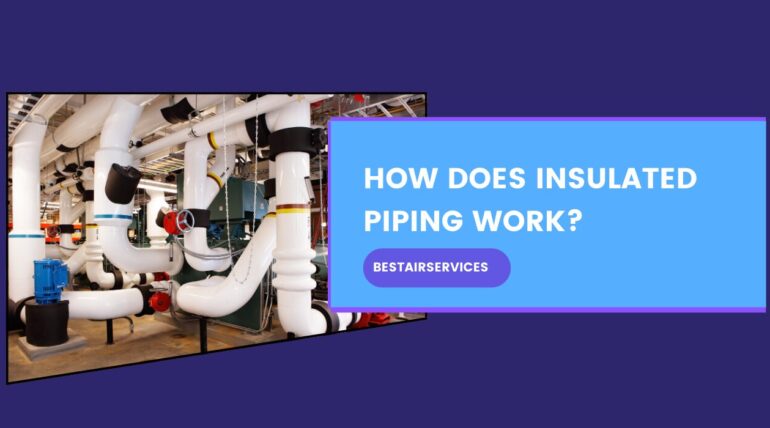
October 23, 2024
Insulated piping systems are essential to keep the heat under check in the cooling, heating, and air conditioning systems of a country like the UAE, where temperatures cross 50°C (122°F) during summer. As informed by the Ministry of Climate Change and Environment within the UAE, energy consumption is estimated to rise by 30 percent in the next ten years with such dynamic urbanization and population growth. In such times, energy efficiency becomes all the more important.
Insulation reduces energy loss, thus being very important for commercial buildings and industrial applications. Studies show that in uninsulated pipes, as much as 30% of energy can be wasted due to heat loss. Businesses investing in these insulated piping systems will not only save a lot of carbon but also on energy expenditure.
In this blog, we will explain how insulated piping works, its benefits, types of insulation materials, installation methods, and maintenance tips. We will also explain why you should choose a reputable service provider such as BestAirServices for all your HVAC needs.
Quick Overview: How Insulated Piping Works
Insulated piping creates a thermal barrier that minimizes the energy transferred between a pipe and its surroundings or, in other words, minimizes heat transfer. This insulation is multifunctional:
- Heat Retention: For hot fluids flowing through insulated pipes, the insulation does not allow the heat to be lost to the surroundings.
- Temperature Maintenance: This protects the pipe system from incoming outer heat in case cold fluids come in.
Key Mechanisms
- Thermal Resistance: These materials have low thermal conductivity, meaning they resist heat flow very well. That is essential for maintaining temperatures in a relatively stable range.
- Moisture Control: Pipe insulation prevents condensation on cold surfaces by ensuring that surface temperature does not rise above the dew point.
- Energy Efficiency It tends to decrease the load on the heating and cooling system as heat loss from hot pipes is minimized and heat gain from cold pipes is minimized.
Benefits of Insulated Piping
Apart from saving energy, there are the following specific benefits of using insulated pipes:
- Energy Savings: Insulated pipes save quite large amounts of energy because fluid temperatures are maintained.
- Protection from Freezing: Water inside these tubes never freezes in cold seasons due to insulation.
- Condensation Control: It keeps condensation to an almost negligible extent on refrigerant pipes as well as any cold pipe to prevent mold formation and structural damage
- Sound Sub-duction: Certain types of insulation can be noise-dampening and thus useful in most residential and commercial applications
- Fire Resistance: Some types of insulation are fire-resistant.
Types of Insulation Materials
Some factors determine the material used for insulation. Some common types include the following:
1. Fiberglass Insulation
This option is widely used because it is highly resistant to thermal changes. It is used in both hot and cold applications.
2. Foam Insulation
Polyurethane or polyethylene foam is highly insulating and less thick. It is excellent at preventing moisture from condensing inside.
3. Mineral Wool
Mineral wool is used in high temperatures as it provides excellent fire resistance and good insulation.
4. Rubber Insulation
Rubber-based insulation is flexible, thus easily installable, and commonly installed on hot and cold water pipes.
5. Polystyrene Foam
Lightweight and with good thermal resistance, foam made from polystyrene is easy to handle for installation.
Installation Methods Of Piple Insulation
Proper installation of insulated piping maximizes effectiveness. Here’s a step-by-step guide:
- Preparation:
- Gather necessary tools: insulation material (foam or fiberglass), duct tape or zip ties, scissors/knife, tape measure.
- Turn off the water supply and drain the pipes.
- Measurement:
- Measure the length and diameter of the pipes needing insulation.
- Cutting the Material:
- Cut insulation material according to measured dimensions.
- Applying Insulation:
- Wrap or slide insulation over the pipe snugly.
- Securing Joints:
- Use duct tape or zip ties to secure any joints or seams in the insulation.
- Weatherproofing (if necessary):
- For outdoor installations, cover with weatherproof material like aluminum foil tape.
Maintenance Tips
The preservation of insulated piping systems ensures longevity:
- Regular Inspection: Scavenge around for signs of wear or damage.
- Moisture Control: There must not be any leaks that compromise the integrity of the insulation material.
- Cleaning: Keep areas devoid of debris that may help trap moisture.
- Professional Assessment: Ensure you schedule regular assessments by professionals in this line, such as BestAirServices.
Why Choose BestAirServices?
BestAirServices is an industry leader in HVAC solutions across the UAE in a quality service market. They are committed to excellence and client satisfaction and provide a wide range of HVAC, refrigeration, and electrical services that can be used to meet diverse needs.
Important Feature of BestAirServices:
Excellence: Experienced personnel to offer world-class quality and performance on all projects.
Full-Service Offering: State-of-the-art HVAC and reliable refrigeration solutions.
Customer-Centric: Built reputation around meeting customer needs with best-of-class offerings.
On-Time Completions: Delivering the projects on budget as well as on time.
Quality Focus: Stringent standards for quality assurance ensure exceptional performance every time.
With BestAirServices, you gain unmatched expertise and industry benchmarks to execute your projects efficiently and effectively.
In a nutshell!
Insulated piping would greatly increase energy efficiency while preserving infrastructure from environmental factors across various sectors in the UAE. It would also provide business organizations with knowledge of how insulated piping works and its benefits, enabling them to make informed decisions regarding heating and cooling systems.
For those requiring customized help from experts well prepared for conditions as extreme as those in the UAE, BestAirServices boasts top-of-line services to get the job done as effectively as possible.
FAQs
What is pipe insulation?
Pipe insulation refers to materials put around pipes that prevent heat loss or gain and condensation reduction.
How does pipe insulation work?
It prevents heat loss between the pipe and the surrounding environment by creating a thermal barrier.
What are some common materials used for pipe insulation?
Common ones include fiberglass, foam (polyurethane), mineral wool, rubber, and polystyrene foam.
Can I install pipe insulation myself?
You can install it by measuring your pipes, cutting the insulation material accordingly, wrapping it around securely, and sealing any joints with tape or zip ties.
Why should I insulate my pipes?
Insulation of pipes saves you money on utility costs as most heat is lost or gained, prevents freezing and bursting in cold weather, and reduces condensation damage.
To understand these aspects of insulated piping systems, you can assure performance and contribute to energy conservation efforts in your environment, justifying BestAirServices as the right partner for all your HVAC needs.


